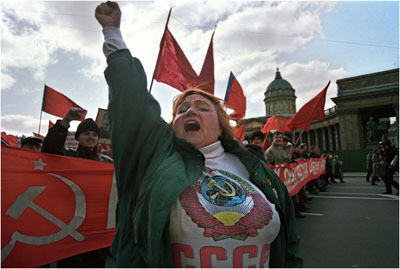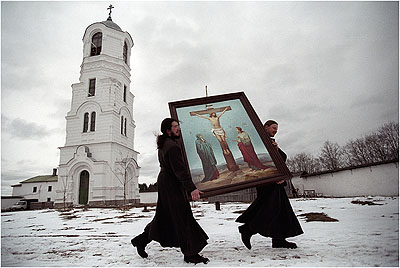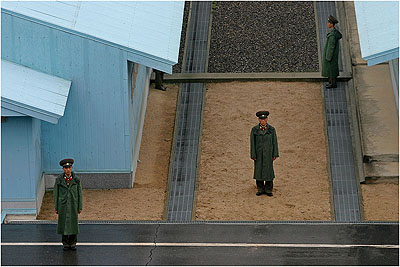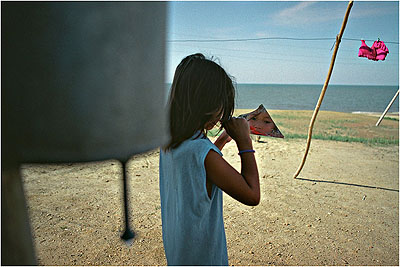
© Sergey Maximishin
Sergey Maximishin »
les deux versants de l'Oural
Exhibition: 15 Mar – 8 Apr 2007
Galerie Albert Benamou
24, rue de Penthièvre
75008 Paris
Galerie Benamou Lage Maxe
7 rue Froissart
75003 Paris
+33(0)1-45 63 12 21

Région de Léningrad, 2001
© Sergey Maximishin
Russian photographer Sergey Maximishin is to display, at the Albert Benamou gallery in Paris his implacable testimonies of the world, from the 14th March up until the 7th April 2007. From his travels in countries outside the international political scene, ravaged by war or abandoned by the media and thus forgotten by the general public, Sergey Maximishin brings back poignant and deeply moving images that reveal its artistic sense and its humanity. His sensibility takes him to territories where chaos has settled in. The photos are taken at the peril of his life and often under extreme conditions in North Korea, in Iraq, and in the countries of the former Soviet Union. A realism without defect and the neutrality of his images reveal a hardened reporter but also a man marked by compassion. Through his pictures, Maximishin denounces the distress of human beings amidst the grip of natural disasters. One can see a girl sitting near her doll and playing with the sand which buried this once prosperous place on the North of Russia, transformed into a ghost coastal city of 300 inhabitants, following the aftermath of an ecological disaster. The artist also denounces the military dictatorships and their absurdness (for instance, photos of North Korean soldiers standing straight and still on the border of South Korea), as well as the misery of abandoned children and their daily struggle to survive by themselves (such as orphans from the streets of St-Petersburg). Maximishin focuses almost exclusively on the everyday life, and by his meetings, he tries above all to tell how the others live. According to him, the emotion given by photography is not different from painting, the theater, the cinema or sculptures; as he explains it himself, harmony between shapes contents is a criteria by which a good image is realised: "Contents (what is or are photographed) are conversations carried out between men. The shape is a conversation between man and God". He works only with natural light and never retouches his photos. Born in 1964, having spent his childhood in Kerch, in the Crimea, Maximishin was given his very first photographer's assignment : that of a report on Fidel Castro's visit to his regiment, whilst he was doing his military service at the heart of the group Soviet Military Force in Cuba from 1985 to 1987. His vocation was launched and after having studied in St.Petersburg's faculty of photojournalism, he became a permanent photographer of the Russian newspaper 'Izvetia', the Russian newspaper, and works as well with 'Focus', the German Agency. Prize-winner of numerous awards (two World Press in 2004 and 2006) has led to the fact that, some of the most important newspapers and international magazines, (The Times, The Wall street Journal, etc.) regularly call on him. The selection of photos made by Albert Benamou and Albert Koski reveal the most striking stages of his journeys and of his critical vision of humanity.
Le photographe russe Sergey Maximishin expose, à la galerie Albert Benamou du 14 mars au 7 avril 2007, ses implacables témoignages du monde. De ses voyages dans des pays en marge de la scène politique internationale, ravagés par la guerre ou délaissés des médias et donc oubliés du grand public, il rapporte des images poignantes et bouleversantes qui révèlent son sens artistique et son humanité. Sa sensibilité l'amène dans des territoires où le chaos s'est installé. Les photos sont prises au péril de sa vie et souvent dans des conditions extrêmes en Corée du Nord, en Irak, et dans les pays de l'ex Union soviétique. Un réalisme sans faille et la neutralité de ses images révèlent un reporter aguerri mais aussi un homme empreint de compassion. A travers ses clichés, Maximishin dénonce le désarroi des êtres humains en proie aux catastrophes naturelles. On peut voir une petite fille assise près de sa poupée et jouant avec le sable qui a enseveli cet ancien lieu prospère, du nord de la Russie, transformé en une ville côtière fantôme de 300 habitants, à la suite d'un désastre écologique. Il dénonce aussi les dictatures militaires et leur absurdité (photos des militaires nord coréens se tenant debout et immobiles à la frontière avec la Corée du sud), ainsi que la misère des enfants livrés à eux mêmes (orphelins des rues de Saint-Pétersbourg). Maximishin se concentre presque exclusivement sur la vie quotidienne, et par ses rencontres, il cherche avant tout à raconter comment vivent les autres. Selon lui, l'émotion que donne la photographie ne diffère pas de celle donnée par la peinture, le théâtre, le cinéma ou la sculpture; comme il le dit lui-même, l'harmonie entre la forme et le contenu est un critère pour réaliser une bonne image :'Le contenu (ce qui est photographié) est une conversation entre l'homme et l'homme. La forme est une conversation entre l'homme et Dieu.' Ne travaillant qu'avec la lumière naturelle et ne retouchant jamais ses photos. Né en 1964, après avoir passé son enfance à Kertch, en Crimée, il se voie confié sa toute première mission de photographe, un reportage sur la visite de Fidel Castro dans son régiment, alors qu'il fait son service militaire au sein du groupe de Force Militaire Soviétique à Cuba de 1985 à 1987. Sa vocation est lancée et après des études à la faculté de photojournalisme de Saint-Pétersbourg, il devient photographe permanent du journal russe 'Izvetia' et travaille aussi avec l'agence allemande 'Focus'. Lauréat de nombreux prix (deux World presse en 2004 et 2006 ), les plus importants journaux et magazines internationaux (The Times, The Wall Street Journal, etc.) font régulièrement appel à lui. La sélection de photographies faite par Albert Benamou et Albert Koski révèlent les étapes les plus marquantes de ses itinéraires et de sa vision critique de l'humanité.

Corée du Nord, 2005
© Sergey Maximishin

© Sergey Maximishin